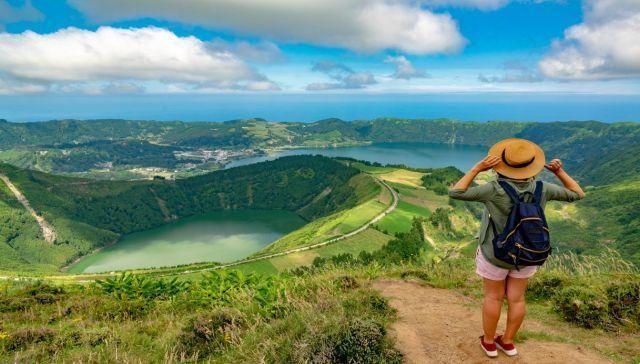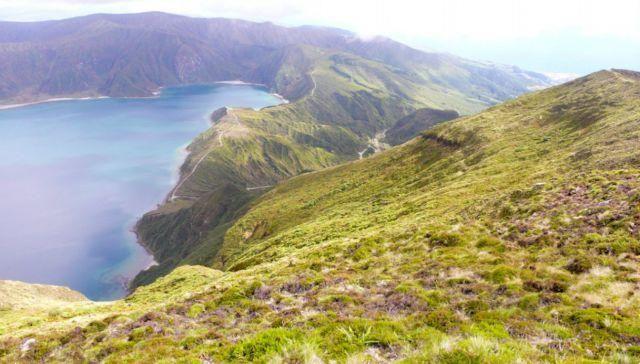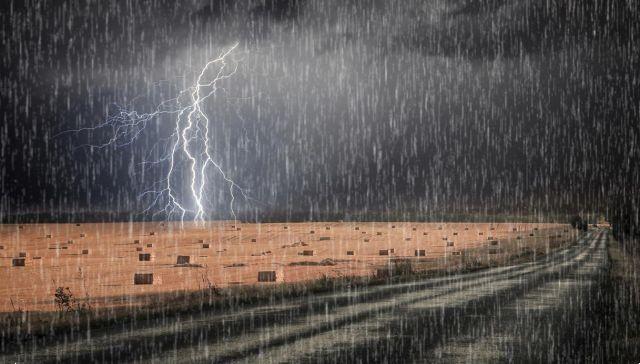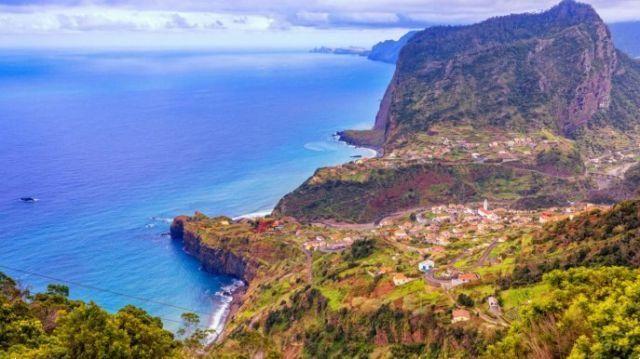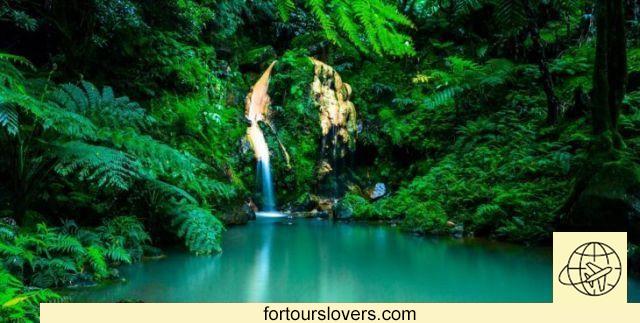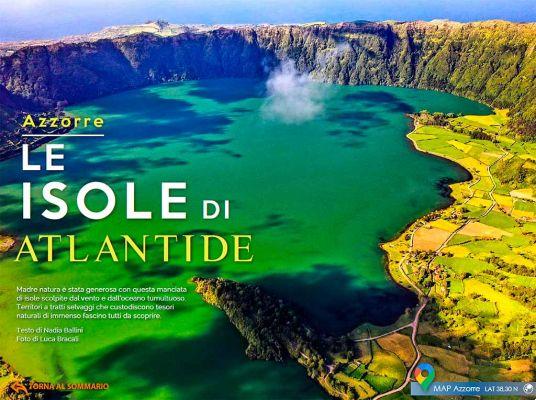 A trip to the Azores islands will allow you to discover beaches and volcanoes immersed in dream landscapes where time seems to have stopped.
A trip to the Azores islands will allow you to discover beaches and volcanoes immersed in dream landscapes where time seems to have stopped.
Just under two hours' flight from Lisbon, the Azores islands are a completely unexpected cross-section of Portugal located in the heart of the Atlantic Ocean. The Azores are made up of 9 islands, all with a very distinct characteristic imprint, and offer beautiful landscapes, lush nature and dream beaches that will make sunbathers and sports enthusiasts happy, attracted by the possibility of practicing all types of surfing.
The main island is São Miguel (Azores), the largest in the archipelago and where half of the entire population of the Azores lives. Thanks to the presence of Ponta Delgada airport, the majority of tourists are also concentrated here, attracted by incredible lakes such as the Caldeira das Sete Cidades or the São Brás Fort, built in the sixteenth century to protect citizens from pirate attacks.
In São Miguel you can visit the incredible tea plantation, Plantações de Chá Gorreana, evidence of a flora capable of mixing oriental plants with those typical of continental Europe, or get lost discovering churches and convents with strictly white walls. If you want to take a dip inside an extinct volcano in the Azores, don't miss a visit to the islet of Villa Franca, while if you prefer beach life, the Praia da Ribeira Quente will keep you busy for hours thanks to the underground springs that heat the water. water and will make you forget you are in the middle of the Atlantic Ocean.
São Miguel is located in the eastern Azores, a group of which the small island of is also part Santa Maria. Some excellent beaches in the Azores are found here, thanks to their sheltered location within the Baía de São Lourenço set by terraces on which vines are grown for the production of local wines. In the southern area of the island you will find Praia Formosa, perhaps the most famous and well-equipped beach in Santa Maria. In and around Ribeira Grande and Azenhas de Baixo you can see numerous water and windmills typical of the Azores, and if you love sea excursions, don't forget to explore the coast or reach the cave on the Romeiro islet.
Leaving by ferry from São Miguel it is possible to reach Praia da Vitoria on the island of Terceira (Azores) in the central Azores. It is an island where the atmosphere is relaxed and you cannot miss a visit to the historic center of the capital, Angra do Heroísmo, a town included in the list of UNESCO world heritage sites and characterized by an elaborate intersection of streets and alleys on which overlooking gardens, palaces and churches with very unique color contrasts among which the lilac color stands out.
If you want to live a beach life, then head towards Praia dos Biscoitos which has some beautiful natural pools among the rocks, while if you love nature you will find magical places such as the Caldeira de Guilherme Moniz, with the large patch of wild heather, or the fumaroles of the Furnas do Enxofre. In the part of the island of Terceira overlooking the bay of Praia da Vitória you can practice sports such as surfing and water skiing or plan trips to the sea in a dinghy or sailing boat. Not to mention that this is one of the best areas in the Azores for whale and dolphin watching.
Another ferry trip and here we are São Jorge, one of the wildest and most peaceful jewels of the Azores islands. Little visited by tourists, it has managed to maintain an authentic atmosphere which is perfect for those who want to treat themselves to a couple of days of total relaxation surrounded by greenery. Crossed by a mountain range, it offers a breathtaking view of the ocean from the over 1.000 meters of Pico de Esperança; the villages of Calheta and Topo, then, are full of postcard views.
Also not to be missed, is the baroque church of Santa Barbara in Manadas with its decorated wooden carved walls and azulejo panels. Here you will also find cheese from the island of São Jorge, probably the most famous product of the Azores; in Fajã dos Vimes, however, there is one of the very few coffee cultivations in Europe. The beach of Fajã da Caldeira do Santo Cristo is particularly beautiful and will repay you for the considerable effort to reach this area which is a nature reserve and therefore particularly rich in flora and fauna typical of the place.
South of São Jorge we find Pico, the island of the Azores with the highest observation point located on the mountain of the same name. Since 2004, its vineyards have been a UNESCO world heritage site thanks to their organization in a network delimited by basalt walls. If once the island was one of the points from which ships departed for sperm whale hunting, today it is a paradise for those who want to admire whales and dolphins up close, thanks to the excursions offered by local boats. In addition to the Gruta das Torres lava tunnel, the island of Pico is equipped with a widespread network of paths and nature itineraries for trekking or mountain bike excursions, which will lead you to its lakes or to the imposing Arcos do Cachorro.
Next to Pico, there is the island of Faial with the delightful little port of Horta representing its largest centre. Here you will find the Scrimshaw Museum with its collection of whale bone objects and nearby there are beaches such as Porto Pim and Conceição as well as that of Almoxarife, with dark sand and a privileged view of the Pico mountain. Nature also plays an important role in Faial and it is possible to take part in excursions inland or at sea in search of whales and dolphins.
The last of the central Azores is the island of Graciosa where the climate is mild and which has sources of thermal water at 40°C such as those of Carapacho, ideal for a relaxing bath. Also not to be missed is a visit to the suggestive Furna do Enxofre, a tunnel that leads to a large cave with an underground lake of sulphurous water. The landscape is full of imposing stone mills; while in Santa Cruz, the white buildings, churches and cobbled streets will make visitors fall in love, who will also appreciate the local restaurants where they can find fish-based dishes, but also many exotic fruits.
The little island of Flores, instead, it is the largest of the western Azores and represents the westernmost point of Europe. Known for its vegetation, it has waterfalls and streams for kayaking. The town of Santa Cruz das Flores is its main centre, where you can admire churches and stately homes. From Lajes, however, it can be reached Corvo, which with its 300 inhabitants is the smallest of the Azores islands. Appreciated by birdwatchers, Corvo allows you to observe many species of birds in a practically uncontaminated paradise, while the beaches of Praia da Areia and Porto da Casa are perfect between a bicycle excursion and a stop to discover the local gastronomy.




